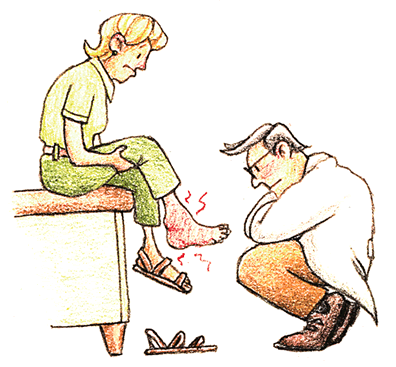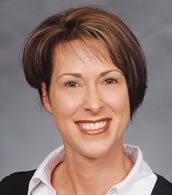Rare Diabetes
Foot Complication
Becoming More Common
Annette Caporusso, DPM, FACFAS
Podiatric Medicine
Chippewa Valley Orthopedics & Sports Medicine
Eau Claire
Few people with diabetes know about the limb-threatening foot condition, or its warning signs.
“As the foot’s structure collapses, the bottom of the foot can become convex, bulging like the hull of a ship. But diabetes patients frequently won’t feel any pain because they have severe nerve damage in their lower extremities.”
As diabetes rates soar nationwide, as a Chippewa Valley Foot and Ankle Surgeon, I am seeing more patients with a rare diabetic foot complication right here in the Chippewa Valley area. The condition is called Charcot Foot (pronounced SHAR-co). It involves a sudden softening of the foot’s bones. This can trigger an avalanche of problems, including joint loss, fractures, collapse of the arch, massive deformity, ulcers, amputation and even death.
 This lack of sensation combined with foot deformity can lead to foot wounds that may initially go unnoticed until severe.
This lack of sensation combined with foot deformity can lead to foot wounds that may initially go unnoticed until severe.
Every person with diabetes should know the Charcot Foot warning signs: a red, hot, swollen foot or ankle. Several other dangerous conditions, such as deep vein thrombosis and acute infections, share these symptoms. A red, hot, swollen foot or ankle requires emergency medical care. The American College of Foot and Ankle Surgeons (ACFAS) estimates less than one percent of people with diabetes develop Charcot Foot. But nationwide, the College’s 6,000 members say they’re noticing more Charcot cases as more Americans develop diabetes.
Charcot cannot be reversed, but its destructive effects can be stopped if the condition is detected early. People with diabetes play a vital role in preventing Charcot Foot and its complications. Diabetes patients should keep blood sugar levels under control. This has been shown to reduce the progression of nerve damage in the feet. People with diabetes should also inspect both of their feet every day, and get regular check-ups from a foot and ankle surgeon. If wounds or ulcers are discovered they should contact their doctor as soon as possible.

Dr. Annette Caporusso is board certified in Reconstructive Rearfoot and Ankle Surgery and earned her podiatric medical degree from Temple University. She is also a member of the American Professional Wound Care Association and an associate member of the American College of Hyperbaric Medicine. Dr. Caporusso is the Podiatric Medical Director of the OakLeaf Advanced Wound Care and Hyperbaric Medicine Center and has been practicing in
the Chippewa Valley for nine years.
Dr. Caporusso – Chippewa Valley Orthopedics & Sports Medicine
For information or to schedule an appointment:
715.832.1400 | www.cvosm.com
Dr. Caporusso sees patients in Eau Claire, Chippewa and Durand.





 © 2011 OakLeaf Medical Network and OakLeaf Surgical Hospital. All rights reserved.
© 2011 OakLeaf Medical Network and OakLeaf Surgical Hospital. All rights reserved.